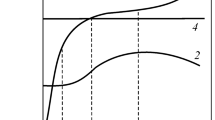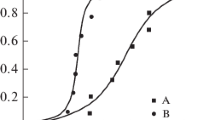Abstract
The new local criterion for brittle fracture in probabilistic definition, which was used by the authors earlier for the KIc(T) prediction, is modified for the case of non-isothermal non-monotonic loading. An approach is put forward which allows predicting the brittle fracture probability for cracked elements under complex thermomechanical loading typical, for example, of the case of emergency cooldown of a reactor pressure vessel. The approach has been verified by comparing the calculated and experimental data of assessment of the influence of various thermomechanical pre-loading modes on the fracture toughness of reactor pressure vessel steels.
Similar content being viewed by others
REFERENCES
PNAÉ G-7-002-86. Strength Analysis Code for Equipment and Pipelines of Nuclear Power Plants [in Russian], Énergoatomizdat, Moscow (1989).
Guidance on the Reactor Pressure Vessel PTS Assessment for WWER Nuclear Power Plants, IAEA, WWER-SC-157 (1996).
B. Z. Margolin, E. Yu. Rivkin, G. P. Karzov, et al., “New approaches for evaluation of brittle strength of reactor pressure vessels,” in: Proc. VIth Int. Conf. Material Issues in Design, Manufacturing, and Operation of Nuclear Power Plants Equipment (St. Petersburg, Russia, 19–23 June 2000) (2000), 1, pp. 159–177.
R. Masson, L. Nicolas, and D. Moinereau,“RPV structural integrity assessment during a PTS event: application of extended Beremin model consistent with WPS test results,” in: Proc. PVP-2002 (Vancouver, Canada, 5–9 August 2002), 443, No.1, 51–56 (2002).
T. R. Wilshaw, C. A. Rau, and A. S. Tetelman,“A general model to predict the elastic distribution and fracture strength of notched bars in plane strain bending,” Eng. Fract. Mech., 1, 191–211 (1968).
R. O. Ritchie, J. F. Knott, and J. R. Rice,“On the relationship between critical tensile stress and fracture toughness in mild steel,” J. Mech. Phys. Solids, 21, 395–410 (1973).
D. A. Curry,“A micromechanistic approach to the warm pre-stressing of ferritic steels,” Int. J. Fract., 17, 335–342 (1981).
G. G. Chell, “The effects of sub-critical crack growth on fracture behavior of cracked ferritic steels after warm prestressing,” Fatigue Fract. Eng. Mater. Struct., 9, 259–274 (1986).
F. M. Beremin, “A local criterion for cleavage fracture for a nuclear pressure vessels steels,” Met. Trans., 14A, 2277–2287 (1983).
Proc. EUROMECH-MECAMAT’96. 1st European Mechanics of Materials Conference on Local Approach to Fracture, Fontainebleau, France, 9–11 Sept. (1996).
G. R. Odette and M. Y. He, “A cleavage toughness master curve model,” J. Nucl. Mat., 283-287, 120–127 (2000).
C. S. Weisner and M. R. Goldthorpe, “The effect of temperature and specimen geometry on the parameters of the “Local approach” to cleavage fracture,” J. de Phys. IV, 295–304 (1996).
B. Z. Margolin, V. A. Shvetsova, and A. G. Gulenko,“Comparison of the Master Curve and Russian Approaches as applied to WWER RPV steels,” in: Use and Applications of the Master Curve for Determining Fracture Toughness (Workshop MASC 2002), Helsinki-Stockholm (2002), pp. 12.1–12.22.
H. Kordisch, R. Boschen, J. G. Blauel, et al., “Experimental and numerical investigations of the warm-prestressing (WPS) effect considering different paths,” Nucl. Eng. Design, 198, 89–96 (2000).
H. Stockl, R. Boschen, W. Schmitt, et al., “Quantification of the warm prestressing effect in a shape welded 10MnMoNi5-5 material,” Eng. Fract. Mech., 67, 119–137 (2000).
B. Z. Margolin and V. A. Shvetsova, “Brittle fracture criterion: structural-mechanical approach,” Probl. Prochn., No. 2, 3–16 (1992).
B. Z. Margolin, V. A. Shvetsova, and G. P. Karzov, “Brittle fracture of nuclear pressure vessel steels. Part I. Local criterion for cleavage fracture,” Int. J. Press. Vess. Piping, 72, 73–87 (1997).
B. Z. Margolin, A. G. Gulenko, and V. A. Shvetsova, “Probabilistic model for fracture toughness prediction based on the new local fracture criteria,” Int. J. Press. Vess. Piping, 75, 307–320 (1998).
B. Z. Margolin, A. G. Gulenko, and V. A. Shvetsova, “Improved probabilistic model for fracture toughness prediction based for nuclear pressure vessel steels,” Int. J. Press. Vess. Piping, 75, 843-855 (1998).
B. Z. Margolin, V. A. Shvetsova, G. P. Karzov, et al., “Application of local approach concept of cleavage fracture to VVER materials,” in: Proc. PVP-2002 (Vancouver, Canada, 5–9 August 2002), 437, 113–120 (2002).
B. Z. Margolin, V. I. Kostylev, and A. I. Minkin, “The effect of ductile crack growth on the temperature dependence for a RPV steel with various degrees of embrittlement,” Int. J. Press. Vess. Piping, 80, 285–296 (2003).
B. Z. Margolin, V. A. Shvetsova, A. G. Gulenko, et al., “Fracture toughness predictions for a reactor pressure vessel steel in the initial and highly embrittled states with the Master Curve approach and a probabilistic model,” Int. J. Press. Vess. Piping, 79, 219–231 (2002).
L. M. Kachalov, Fundamentals of the Theory of Plasticity [in Russian], Nauka, Moscow (1969).
R. Hill, The Mathematical Theory of Plasticity, Clarendon Press, Oxford, (1950).
K. Kishimoto, S. Aoki, and M. Sakata, “On the path independent integral,” Eng. Fract. Mech., 13, 841–850 (1980).
G. A. Korn and T. M. Korn, Mathematical Handbook for Scientists and Engineers, McGraw-Hill Book Company, New York, San Francisco, London (1968).
V. V. Pokrovskii, V. T. Troshchenko, V. G. Kaplunenko, et al., “A promising method for enhancing resistance of pressure vessels to brittle fracture,” Int. J. Press. Vess. Piping, 58, 9–24 (1994).
V. V. Pokrovskii and V. T. Troshchenko, “Assessment of brittle-fracture resistance of reactor steels after thermomechanical loading under different conditions and stability of the positive effect of warm prestressing,” in: Proc. NATO Advanced Research Workshop (ARW): Scientific Fundamentals for the Life Time Extension of Reactor Pressure Vessels, Kiev (2002), pp. 110–125.
A. P. Gusenkov, Strength under Isothermal and Non-Isothermal Low-Cycle Loading [in Russian], Nauka, Moscow (1979).
Author information
Authors and Affiliations
Additional information
Translated from Problemy Prochnosti, No. 1, pp. 24–42, January–February, 2005.
Rights and permissions
About this article
Cite this article
Margolin, B.Z., Kostylev, V.I. & Keim, E. Probabilistic definition of local criterion for brittle fracture under complex thermomechanical loading. Strength Mater 37, 16–29 (2005). https://doi.org/10.1007/s11223-005-0013-2
Received:
Issue Date:
DOI: https://doi.org/10.1007/s11223-005-0013-2




